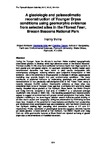A glaciologic and palaeoclimatic reconstruction of Younger Dryas conditions using geomorphic evidence from selected sites in the Fforest Fawr, Brecon Beacons National Park
| dc.contributor.author | Irvine, H. | |
| dc.date.accessioned | 2019-05-20T16:17:00Z | |
| dc.date.available | 2019-05-20T16:17:00Z | |
| dc.date.issued | 2017 | |
| dc.identifier.citation |
Irvine, H. (2017) 'A glaciologic and palaeoclimatic reconstruction of Younger Dryas conditions using geomorphic evidence from selected sites in the Fforest Fawr, Brecon Beacons National Park', The Plymouth Student Scientist, 10(2), p.224-264. | en_US |
| dc.identifier.issn | 1754-2383 | |
| dc.identifier.uri | http://hdl.handle.net/10026.1/14167 | |
| dc.description.abstract |
During the Younger Dryas the climate in southern Wales enabled topographically constrained glaciers to develop within high elevation areas of the Brecon Beacons. Previous studies in this area have attributed numerous basin-floor ridge systems to both glacial and non-glacial origins. An approach considering viability based upon reconstructed dynamics has been found to yield results comparable with contemporary analogues, reducing reliance upon subjective interpretation of field evidence. Due to the sensitivity of cirque glaciers to changes in climate, palaeoglacial modelling may provide insight into past environmental conditions. This study contributes to published literature by undertaking glaciologic and palaeoclimatic reconstructions at four previously uninvestigated sites in the Fforest Fawr, using a recently released ArcGIS toolbox. Geomorphic evidence at these sites was considered likely to be of Younger Dryas age due to similarity with landforms dated nearby. Modelled cirque glaciers at Fan Gyhirych, Blaen Senni, Fan Bwlch Chwyth and Craig Cwm-du occupied a total area of 0.335km2 at a calculated average Equilibrium Line Altitude of 496m ASL. The resulting palaeoclimatic reconstructions appear to suggest an environment with greater annual precipitation than today. Solar radiation modelling of the June-August ablation season indicates partial shading of all sites due to aspect and topography, aiding ice preservation by minimising surface mass loss. Analysis of the potential for mass balance contribution from avalanches and windblown snow accumulation was also considered, with Fan Bwlch Chwyth and Fan Gyhirych yielding high prevailing wind snowblow factors of 5.2 and 2.1 respectively. Finally, calculation of glaciological dynamics suggests relatively inactive yet viable glaciers to have existed at Fan Gyhirych, Fan Bwlch Chywth and Craig Cwm-du, while geomorphic features at Blaen Senni are rejected as being of glacial origin due to the dimensions of modelled ice extent. | en_US |
| dc.language.iso | en | en_US |
| dc.publisher | University of Plymouth | |
| dc.rights | Attribution 3.0 United States | * |
| dc.rights.uri | http://creativecommons.org/licenses/by/3.0/us/ | * |
| dc.subject | Younger Dryas | en_US |
| dc.subject | southern Wales | en_US |
| dc.subject | glaciers | en_US |
| dc.subject | geomorphic | en_US |
| dc.subject | Brecon Beacons National Park | en_US |
| dc.subject | palaeoglacial modelling | en_US |
| dc.subject | snow accumulation | en_US |
| dc.title | A glaciologic and palaeoclimatic reconstruction of Younger Dryas conditions using geomorphic evidence from selected sites in the Fforest Fawr, Brecon Beacons National Park | en_US |
| dc.type | Article | |
| plymouth.issue | 2 | |
| plymouth.volume | 10 | |
| plymouth.journal | The Plymouth Student Scientist |



